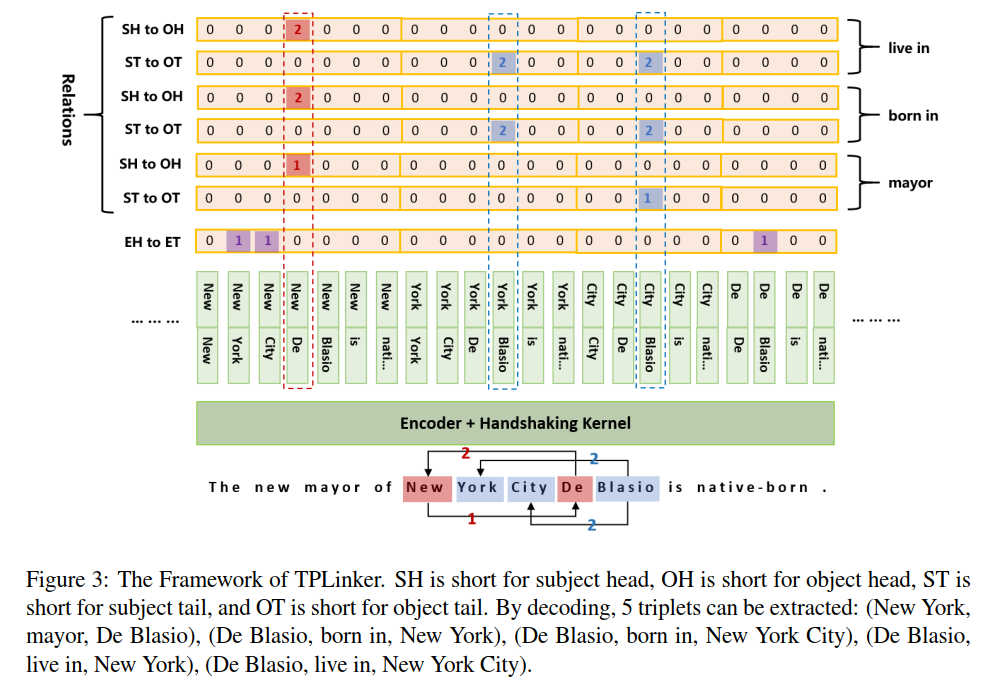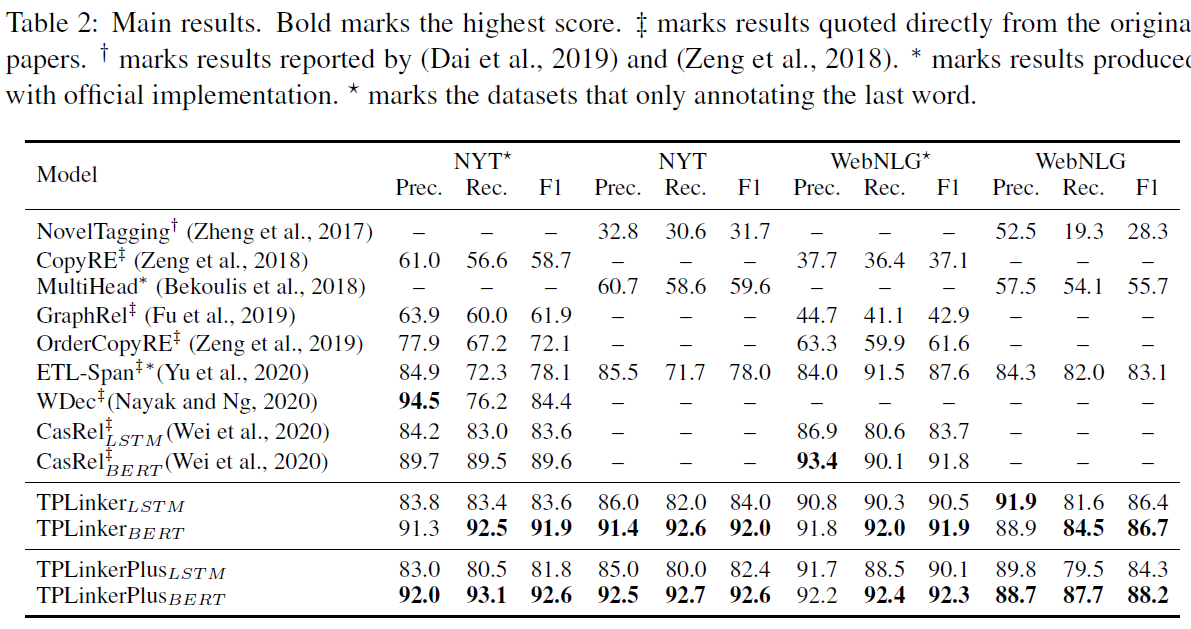TPLinker: Single-stage Joint Extraction of Entities and Relations Through Token Pair Linking
This repository contains all the code of the official implementation for the paper: TPLinker: Single-stage Joint Extraction of Entities and Relations Through Token Pair Linking. The paper has been accepted to appear at COLING 2020. [slides] [poster]
TPLinker is a joint extraction model resolved the issues of relation overlapping and nested entities, immune to the influence of exposure bias, and achieves SOTA performance on NYT (TPLinker: 91.9, TPlinkerPlus: 92.6 (+3.0)) and WebNLG (TPLinker: 91.9, TPlinkerPlus: 92.3 (+0.5)). Note that the details of TPLinkerPlus will be published in the extended paper, which is still in progress.
Note: Please refer to Q&A and closed issues to find your question before proposed a new issue.
- 2020.11.01: Fixed bugs and added comments in BuildData.ipynb and build_data_config.yaml; TPLinkerPlus can support entity classification now, see build data for the data format; Updated the datasets (added
entity_listfor TPLinkerPlus). - 2020.12.04: The original default parameters in
build_data_config.yamlare all for Chinese datasets. It might be misleading for reproducing the results. I changed back to the ones for English datasets. Note that you must setignore_subwordtotruefor English datasets, or it will hurt the performance and can not reach the scores reported in the paper. - 2020.12.09: We published model states for fast tests. See Super Parameters.
- 2021.03.22: Add Q&A part in README.
Our experiments are conducted on Python 3.6 and Pytorch == 1.6.0. The main requirements are:
- tqdm
- glove-python-binary==0.2.0
- transformers==3.0.2
- wandb # for logging the results
- yaml
In the root directory, run
pip install -e .Get and preprocess NYT* and WebNLG* following CasRel (note: named NYT and WebNLG by CasRel).
Take NYT* as an example, rename train_triples.json and dev_triples.json to train_data.json and valid_data.json and move them to ori_data/nyt_star, put all test*.json under ori_data/nyt_star/test_data. The same process goes for WebNLG*.
Get raw NYT from CopyRE, rename raw_train.json and raw_valid.json to train_data.json and valid_data.json and move them to ori_data/nyt, rename raw_test.json to test_data.json and put it under ori_data/nyt/test_data.
Get WebNLG from ETL-Span, rename train.json and dev.json to train_data.json and valid_data.json and move them to ori_data/webnlg, rename test.json to test_data.json and put it under ori_data/webnlg/test_data.
If you are bother to prepare data on your own, you could download our preprocessed datasets.
Build data by preprocess/BuildData.ipynb.
Set configuration in preprocess/build_data_config.yaml.
In the configuration file, set exp_name corresponding to the directory name, set ori_data_format corresponding to the source project name of the data.
e.g. To build NYT*, set exp_name to nyt_star and set ori_data_format to casrel. See build_data_config.yaml for more details.
If you want to run on other datasets, transform them into the normal format for TPLinker, then set exp_name to <your folder name> and set ori_data_format to tplinker:
[{
"id": <text_id>,
"text": <text>,
"relation_list": [{
"subject": <subject>,
"subj_char_span": <character level span of the subject>, # e.g [3, 10] This key is optional. If no this key, set "add_char_span" to true in "build_data_config.yaml" when you build the data
"object": <object>,
"obj_char_span": <character level span of the object>, # optional
"predicate": <predicate>,
}],
"entity_list": [{ # This key is optional, only for TPLinkerPlus. If no this key, BuildData.ipynb will auto genrate a entity list based on the relation list.
"text": <entity>,
"type": <entity_type>,
"char_span": <character level span of the object>, # This key relys on subj_char_span and obj_char_span in relation_list, if not given, set "add_char_span" to true in "build_data_config.yaml".
}],
}]Download BERT-BASE-CASED and put it under ../pretrained_models. Pretrain word embeddings by preprocess/Pretrain_Word_Embedding.ipynb and put models under ../pretrained_emb.
If you are bother to train word embeddings by yourself, use our's directly.
Set configuration in tplinker/config.py as follows:
common["exp_name"] = nyt_star # webnlg_star, nyt, webnlg
common["device_num"] = 0 # 1, 2, 3 ...
common["encoder"] = "BERT" # BiLSTM
train_config["hyper_parameters"]["batch_size"] = 24 # 6 for webnlg and webnlg_star
train_config["hyper_parameters"]["match_pattern"] = "only_head_text" # "only_head_text" for webnlg_star and nyt_star; "whole_text" for webnlg and nyt.
# if the encoder is set to BiLSTM
bilstm_config["pretrained_word_embedding_path"] = ""../pretrained_word_emb/glove_300_nyt.emb""
# Leave the rest as defaultStart training
cd tplinker
python train.py
TPLinker
# NYT*
T_mult: 1
batch_size: 24
dist_emb_size: -1
ent_add_dist: false
epochs: 100
inner_enc_type: lstm
log_interval: 10
loss_weight_recover_steps: 12000
lr: 0.00005
match_pattern: only_head_text
max_seq_len: 100
rel_add_dist: false
rewarm_epoch_num: 2
scheduler: CAWR
seed: 2333
shaking_type: cat
sliding_len: 20
# NYT
match_pattern: whole_text
...(the rest is the same as above)
# WebNLG*
batch_size: 6
loss_weight_recover_steps: 6000
match_pattern: only_head_text
...
# WebNLG
batch_size: 6
loss_weight_recover_steps: 6000
match_pattern: whole_text
...
We also provide model states for fast tests. You can download them here! You can get results as follows:
Before you run, make sure:
1. transformers==3.0.2
2. "max_test_seq_len" is set to 512
3. "match_pattern" should be the same as in the training: `whole_text` for NYT/WebNLG, `only_head_text` for NYT*/WebNLG*.
# The test_triples and the test_data are the complete test datasets. The tuple means (precision, recall, f1).
# In the codes, I did not set the seed in a right way, so you might get different scores (higher or lower). But they should be very close to the results in the paper.
# NYT*
{'2og80ub4': {'test_triples': (0.9118290017002562,
0.9257706535141687,
0.9187469407233642),
'test_triples_1': (0.8641055045871312,
0.929099876695409,
0.8954248365513463),
'test_triples_2': (0.9435444280804642,
0.9196172248803387,
0.9314271867684752),
'test_triples_3': (0.9550056242968554,
0.9070512820511851,
0.9304109588540408),
'test_triples_4': (0.9635099913118189,
0.9527491408933889,
0.9580993520017547),
'test_triples_5': (0.9177877428997133,
0.9082840236685046,
0.9130111523662223),
'test_triples_epo': (0.9497520661156711,
0.932489451476763,
0.9410415983777494),
'test_triples_normal': (0.8659532526048757,
0.9281617869000626,
0.895979020929055),
'test_triples_seo': (0.9476190476190225,
0.9258206254845974,
0.9365930186452366)}}
# NYT
{'y84trnyf': {'test_data': (0.916494217894085,
0.9272167487684615,
0.9218243035924758)}}
# WebNLG*
{'2i4808qi': {'test_triples': (0.921855146124465,
0.91777356103726,
0.919809825623476),
'test_triples_1': (0.8759398496237308,
0.8759398496237308,
0.8759398495737308),
'test_triples_2': (0.9075144508667897,
0.9235294117644343,
0.9154518949934687),
'test_triples_3': (0.9509043927646122,
0.9460154241642813,
0.9484536081971787),
'test_triples_4': (0.9297752808986153,
0.9271708683470793,
0.928471248196584),
'test_triples_5': (0.9360730593603032,
0.8951965065498275,
0.9151785713781879),
'test_triples_epo': (0.9764705882341453,
0.9431818181807463,
0.959537572203241),
'test_triples_normal': (0.8780487804874479,
0.8780487804874479,
0.8780487804374479),
'test_triples_seo': (0.9299698795180023,
0.9250936329587321,
0.9275253473025405)}}
# WebNLG
{'1g7ehpsl': {'test': (0.8862619808306142,
0.8630989421281354,
0.8745271121819839)}}
TPLinkerPlus
# NYT*/NYT
# The best F1: 0.931/0.934 (on validation set), 0.926/0.926 (on test set)
T_mult: 1
batch_size: 24
epochs: 250
log_interval: 10
lr: 0.00001
max_seq_len: 100
rewarm_epoch_num: 2
scheduler: CAWR
seed: 2333
shaking_type: cln
sliding_len: 20
tok_pair_sample_rate: 1
# WebNLG*/WebNLG
# The best F1: 0.934/0.889 (on validation set), 0.923/0.882 (on test set)
T_mult: 1
batch_size: 6
epochs: 250
log_interval: 10
lr: 0.00001
max_seq_len: 100
rewarm_epoch_num: 2
scheduler: CAWR
seed: 2333
shaking_type: cln
sliding_len: 20
tok_pair_sample_rate: 1
Set configuration in tplinker/config.py as follows:
eval_config["model_state_dict_dir"] = "./wandb" # if use wandb, set "./wandb"; if you use default logger, set "./default_log_dir"
eval_config["run_ids"] = ["46qer3r9", ] # If you use default logger, run id is shown in the output and recorded in the log (see train_config["log_path"]); If you use wandb, it is logged on the platform, check the details of the running projects.
eval_config["last_k_model"] = 1 # only use the last k models in to output results
# Leave the rest as the same as the trainingStart evaluation by running tplinker/Evaluation.ipynb
@inproceedings{wang-etal-2020-tplinker,
title = "{TPL}inker: Single-stage Joint Extraction of Entities and Relations Through Token Pair Linking",
author = "Wang, Yucheng and Yu, Bowen and Zhang, Yueyang and Liu, Tingwen and Zhu, Hongsong and Sun, Limin",
booktitle = "Proceedings of the 28th International Conference on Computational Linguistics",
month = dec,
year = "2020",
address = "Barcelona, Spain (Online)",
publisher = "International Committee on Computational Linguistics",
url = "https://www.aclweb.org/anthology/2020.coling-main.138",
pages = "1572--1582"
}
- Why did you make all entities to be "DEFAULT" type? TPLinker can not recognize the type of entities?
Because it is not necessary to recognize the type of entities for the relation extraction task since a predefined relation usually has fixed types for its subject and object. For example, ("place", "contains", "place") and ("country", "capital", "city"). If you need this feature, you can redefine the output tags of the EH-to-ET sequence or use TPLinkerPlus, which has already had this feature. If you use TPLinkerPlus, just set a specific entity type instead of "DEFAULT" in the entity_list.
- What is the difference between <dataset_name>_star and <dataset_name>?
For fair comparison, we use the preprocessed data from previous works. NYT is from CopyRE (the raw version); WebNLG is from ETL-span; NYT* and WebNLG* are from CasRel. For a detailed description of these datasets, please refer to the data description part of our paper.
- Previous works claim that WebNLG has 246 relations. Why do you use the WebNLG and WebNLG* that have less relations?
We directly use the datasets preprocessed by previous SoTA models. We get them from their Github repositories. We recounted the relations in the datasets and found out the real relation number of WebNLG and WebNLG* are less than they claimed in the papers. In fact, they use a subset (6000+ samples) WebNLG instead of the original WebNLG (10000+ samples) but use the statistics of the original one. If you re-count the relations in their datasets you will also find this problem.
- My training process is far slower than you claimed (24h). Could you give any suggestions?
Please use the hyper-parameters I provided in README to reproduce the results. If you want to change them, please make the max_seq_length of training less than or equal to 100. From my experience, increasing the max_seq_length to larger than 100 did not bring obvious improvement but hurt the training speed so much. Using smaller batch_size will also speed up the training but it might hurt the performance if you use too small batch_size.
- I see you split the long text to short ones. You might miss some golden entities and relations by splitting. How do you handle this?
We use a sliding window to split the samples, which will contain the most part of golden entities and relations. And we use different max_seq_length for training and inference. The former is set to 100 and the latter is set to 512. It is ok to lose one or two entities or relations when training, which will not influence the training too much.
- How to use this model for Chinese datasets?
Please refer to issue #15.
- My f1 score stay at 0 for a very long time. Do you have any idea?
Please refer to issue #24 and #25.



